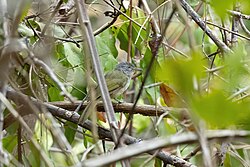| Image | Scientific name | Common name | Distribution |
|---|
 | Lowland tiny greenbul | Phyllastrephus debilis | East Africa |
| - | Montane tiny greenbul | Phyllastrephus albigula | Usambara and Nguru Mountains |
 | White-throated greenbul | Phyllastrephus albigularis | African tropical rainforest |
| - | Angola greenbul | Phyllastrephus viridiceps | northwestern Angola |
| - | Xavier's greenbul | Phyllastrephus xavieri | Congolian rainforests |
 | Icterine greenbul | Phyllastrephus icterinus | African tropical rainforest |
 | Terrestrial brownbul | Phyllastrephus terrestris | miombo, fynbos and east Africa |
| - | Cameroon olive greenbul | Phyllastrephus poensis | Western High Plateau |
 | Northern brownbul | Phyllastrephus strepitans | northern East Africa |
| - | Grey-olive greenbul | Phyllastrephus cerviniventris | miombo and East Africa |
| - | Fischer's greenbul | Phyllastrephus fischeri | southern Somalia to northern Mozambique |
 | Cabanis's greenbul | Phyllastrephus cabanisi | miombo and East Africa |
| - | Red-tailed leaflove | Phyllastrephus scandens | African tropical rainforest |
| - | Sassi's olive greenbul | Phyllastrephus lorenzi | Congo Basin (north-east) |
 | Yellow-streaked greenbul | Phyllastrephus flavostriatus | Afromontane |
| - | Sharpe's greenbul | Phyllastrephus alfredi | south-western Tanzania, north-eastern Zambia and northern Malawi |
| - | Grey-headed greenbul | Phyllastrephus poliocephalus | Western High Plateau |
| - | Toro olive greenbul | Phyllastrephus hypochloris | East African montane forests
and northern Victoria Basin |
| - | Baumann's greenbul | Phyllastrephus baumanni | sparsely present across southern West Africa |
 | Pale-olive greenbul | Phyllastrephus fulviventris | gallery forests of southwestern Central Africa |
|









